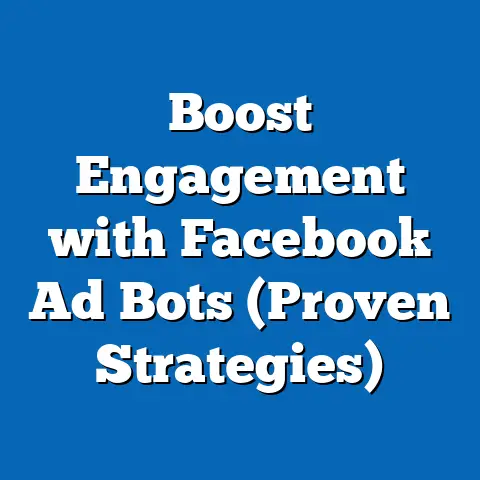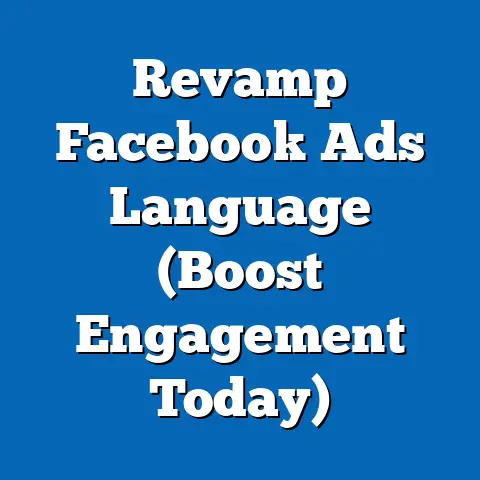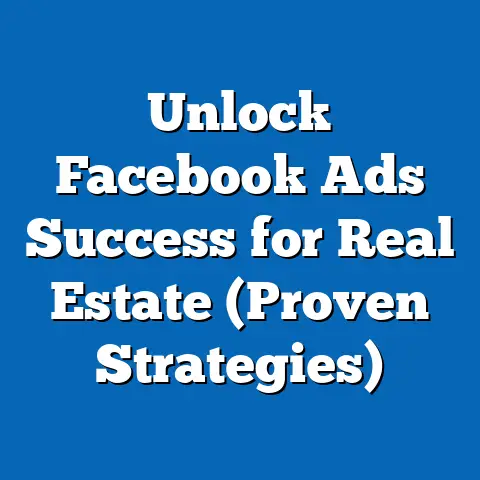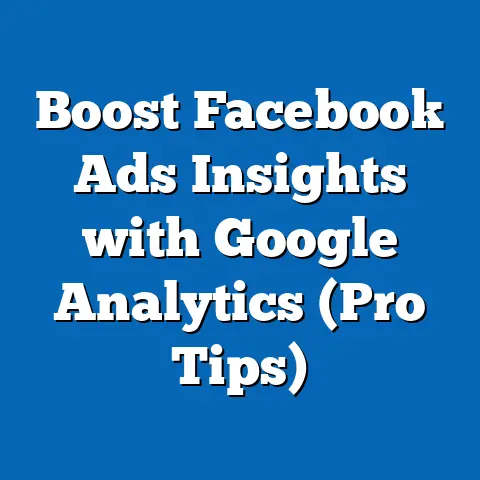Transform Facebook Ads for Real Estate Success (Proven Strategies)
As a digital marketing specialist, I’ve seen firsthand how the real estate industry has evolved. What was once a world of newspaper ads and open houses has dramatically shifted towards digital platforms. And among these platforms, Facebook Ads stands out as a particularly comfortable and familiar tool for many real estate professionals. Why? Because it’s where people already are, connecting with friends, family, and communities.
This inherent comfort and familiarity make Facebook a goldmine for real estate marketing. It’s not just about throwing up a listing and hoping someone bites. It’s about creating a nurturing environment, a digital neighborhood where potential buyers and sellers feel a sense of belonging. It’s about leveraging the power of social connection to build trust and generate leads.
I’ve worked with countless real estate agents who were initially hesitant about Facebook Ads. They saw it as just another social media platform, not a serious marketing tool. But with the right strategies, I’ve helped them transform their campaigns, connecting with qualified leads and achieving significant results.
In this guide, I’m going to share those proven strategies with you. We’ll dive deep into the Facebook Ads ecosystem, explore how to craft compelling ad copy, harness the power of visuals, and master the art of targeting and retargeting. We’ll also cover the crucial aspect of analyzing performance and optimizing your campaigns for maximum ROI.
My goal is to empower you with the knowledge and tools you need to transform your Facebook Ads from a potential expense into a powerful engine for real estate success. So, let’s get started!
Section 1: Understanding the Facebook Ads Ecosystem
Before you start throwing money at Facebook, it’s crucial to understand the landscape. Think of Facebook Ads as a complex city. You need to know the different districts (ad formats), the rules of the road (advertising policies), and the best routes to reach your destination (your target audience).
Ad Formats: Choosing the Right Vehicle
Facebook offers a variety of ad formats, each designed for a specific purpose. Choosing the right format is like picking the right vehicle for a journey. A motorcycle might be fun, but it’s not ideal for moving furniture! Here are some key ad formats for real estate:
- Carousel Ads: These allow you to showcase multiple properties (or different aspects of a single property) in a single ad. Think of it as a digital window display. I’ve seen carousel ads work incredibly well for highlighting different features of a luxury home – the gourmet kitchen, the stunning backyard, the luxurious master suite.
- Single Image or Video Ads: Simpler and more direct, these are great for showcasing a single, eye-catching image or a short video tour. A beautiful aerial shot of a property or a quick walkthrough video can be incredibly effective.
- Lead Generation Ads: These are designed specifically to capture leads directly on Facebook. They include a built-in form that users can fill out without leaving the platform. These are fantastic for collecting contact information from interested buyers or sellers. I once ran a lead generation campaign offering a free home valuation, and the results were phenomenal!
- Instant Experience Ads: These are full-screen, mobile-optimized experiences that load instantly when someone clicks on your ad. They’re perfect for creating immersive property tours or showcasing your brand’s story.
- Collection Ads: These ads are ideal for showcasing multiple products (in this case, properties) in a visually appealing format that encourages browsing.
Advertising Objectives: Defining Your Destination
Facebook requires you to choose an advertising objective, which essentially tells the platform what you want your ad to achieve. It’s like setting your GPS before you start driving. Here are some relevant objectives for real estate:
- Awareness: This is about reaching as many people as possible to increase brand visibility. It’s useful for establishing yourself as a local real estate expert.
- Consideration: This focuses on getting people to engage with your ad, whether it’s visiting your website, watching a video, or sending a message.
- Conversion: This aims to drive specific actions, such as filling out a lead form, booking a showing, or making an offer.
The Facebook Algorithm: Your Guiding Compass
The Facebook algorithm determines which ads are shown to which users. It’s a complex system, but understanding the basics can help you optimize your campaigns. The algorithm prioritizes ads that are:
- Relevant: Ads that match the user’s interests and behavior.
- Engaging: Ads that generate likes, comments, shares, and clicks.
- High-Quality: Ads with clear visuals and compelling copy.
To succeed on Facebook, you need to create ads that tick all these boxes.
Demographic and Behavioral Targeting: Pinpointing Your Audience
One of the biggest advantages of Facebook Ads is its powerful targeting capabilities. You can target potential clients based on a wide range of factors, including:
- Demographics: Age, gender, location, education, income, etc.
- Interests: Hobbies, activities, pages they like, etc.
- Behaviors: Purchase history, online activity, travel habits, etc.
- Life Events: Marriage, new job, moving to a new city, etc.
For real estate, this is incredibly valuable. You can target first-time homebuyers, luxury property seekers, investors, or people who are likely to move soon. I remember helping a client target newly married couples who were interested in home decor and DIY projects. The campaign resulted in a significant increase in leads and sales.
Key Takeaway: Understanding the Facebook Ads ecosystem is the foundation for success. Experiment with different ad formats, define clear objectives, and leverage the platform’s powerful targeting capabilities to reach the right audience.
Next Steps: Explore the different ad formats and objectives in Facebook Ads Manager. Start brainstorming potential target audiences based on your ideal client profile.
Section 2: Crafting Compelling Ad Copy
Your ad copy is your sales pitch. It’s what convinces people to click on your ad and learn more about your properties. Think of it as the voice of your brand, the first impression you make on potential clients.
Clear and Concise Messaging: Getting to the Point
In the fast-paced world of social media, attention spans are short. You need to grab people’s attention quickly and convey your message clearly and concisely. Avoid jargon and focus on the benefits of the property.
- Highlight the Unique Selling Proposition (USP): What makes this property special? Is it the stunning views, the convenient location, the luxurious amenities, or the family-friendly neighborhood?
- Focus on Benefits, Not Features: Instead of saying “This house has granite countertops,” say “Enjoy cooking in a gourmet kitchen with beautiful granite countertops.”
- Use Strong Action Verbs: Words like “Discover,” “Explore,” “Imagine,” and “Experience” can create a sense of excitement and intrigue.
Effective Headlines and Calls to Action (CTAs): Guiding the User
Your headline is the first thing people see, so it needs to be attention-grabbing. Your CTA tells them what to do next.
- Headlines: Use numbers, questions, or strong emotional language to grab attention. Examples: “5 Reasons to Buy a Home in [Neighborhood],” “Looking for Your Dream Home?” “Experience Luxury Living in [City].”
- CTAs: Be clear and direct. Use phrases like “Learn More,” “Schedule a Showing,” “Get a Free Home Valuation,” or “Contact Us Today.”
Storytelling: Painting a Picture
Real estate is about more than just bricks and mortar. It’s about lifestyle, community, and dreams. Use storytelling to paint a picture of the life people could have in your properties.
- Focus on the Emotions: How will this property make them feel? Will it provide a sense of security, comfort, luxury, or connection?
- Use Vivid Language: Describe the property in a way that appeals to the senses. Imagine the smell of freshly baked cookies in the kitchen, the sound of children playing in the backyard, or the feel of the warm sun on the balcony.
- Share Success Stories: Feature testimonials from satisfied clients who have found their dream homes through you.
I once created an ad campaign for a beachfront property that focused on the feeling of waking up to the sound of waves and the stunning views of the ocean. The ad copy resonated deeply with potential buyers, and the property sold within weeks.
Key Takeaway: Compelling ad copy is essential for attracting attention, conveying your message, and driving action. Focus on clear messaging, strong headlines and CTAs, and the power of storytelling.
Next Steps: Review your existing ad copy and identify areas for improvement. Experiment with different headlines, CTAs, and storytelling techniques.
Section 3: Visual Appeal – The Power of Imagery and Video
In the visual world of Facebook, imagery and video are king and queen. They’re what stop people in their tracks and make them pay attention to your ads. Think of your visuals as the visual representation of your brand, the first thing people notice before they even read your ad copy.
High-Quality Images and Videos: Capturing Attention
Blurry, poorly lit photos are a surefire way to turn people off. Invest in high-quality visuals that showcase your properties in the best possible light.
- Professional Photography: Hire a professional photographer to capture stunning images of your properties.
- Virtual Tours: Create virtual tours that allow potential buyers to explore the property from the comfort of their own homes.
- Drone Footage: Use drone footage to showcase the property’s location and surroundings.
- Staging: Stage the property to make it look its best. Remove clutter, add furniture, and create a welcoming atmosphere.
Visual Strategies: Showcasing Properties Effectively
There are many creative ways to use visuals to showcase your properties.
- Before and After Photos: Show the transformation of a property with before and after photos.
- Lifestyle Images: Use images that depict the lifestyle associated with the property.
- 360-Degree Photos: Allow potential buyers to explore the property in a fully immersive way.
- Animated GIFs: Create short, animated GIFs that highlight key features of the property.
Optimizing Visuals for Mobile Devices: Reaching the Mobile Audience
A significant portion of Facebook users access the platform via smartphones. Make sure your visuals are optimized for mobile devices.
- Use Vertical Videos: Vertical videos take up more screen space on mobile devices.
- Keep Videos Short: Mobile users have short attention spans. Keep your videos concise and to the point.
- Use Text Overlays: Add text overlays to your videos to convey your message even when the sound is off.
I once helped a client create a series of short, vertical videos showcasing different aspects of a luxury apartment complex. The videos were optimized for mobile devices and included text overlays highlighting key features. The campaign resulted in a significant increase in leads and bookings.
Key Takeaway: High-quality visuals are essential for capturing attention and showcasing your properties effectively. Invest in professional photography, virtual tours, and drone footage. Optimize your visuals for mobile devices to reach the mobile audience.
Next Steps: Review your existing visuals and identify areas for improvement. Experiment with different visual strategies and optimize your visuals for mobile devices.
Section 4: Targeting and Retargeting Strategies
Targeting is the art of reaching the right people with the right message at the right time. Retargeting is the art of re-engaging people who have already shown interest in your brand. Think of targeting as casting a wide net and retargeting as reeling in the ones that got away.
Audience Segmentation: Knowing Your Audience
Not all potential clients are created equal. Segment your audience based on their interests, behaviors, and demographics.
- First-Time Homebuyers: Target people who are likely to be first-time homebuyers, such as young adults, newly married couples, and renters.
- Luxury Property Seekers: Target people who are interested in luxury goods and services, such as high-end cars, designer clothing, and luxury travel.
- Investors: Target people who are interested in real estate investing, such as landlords, property managers, and real estate developers.
- People Who Are Likely to Move Soon: Target people who have recently experienced a life event that might trigger a move, such as a new job, a marriage, or a birth.
Custom Audiences: Reaching Your Existing Contacts
Create custom audiences based on your existing contacts, such as your email list, your website visitors, and your social media followers.
- Email List: Upload your email list to Facebook to target your existing contacts with relevant ads.
- Website Visitors: Use the Facebook Pixel to track website visitors and retarget them with ads based on the pages they visited.
- Social Media Followers: Target your social media followers with ads that encourage them to engage with your content and visit your website.
Facebook Pixel: Tracking User Behavior
The Facebook Pixel is a small piece of code that you install on your website. It allows you to track user behavior and retarget potential leads who have shown interest in certain properties or services.
- Track Page Views: Track which pages people are visiting on your website.
- Track Leads: Track when people fill out a lead form on your website.
- Track Purchases: Track when people make a purchase on your website.
Lookalike Audiences: Expanding Your Reach
Lookalike audiences allow you to reach new potential clients who exhibit similar behaviors to your existing customer base.
- Create a Lookalike Audience Based on Your Email List: Upload your email list to Facebook and create a lookalike audience based on the characteristics of your existing customers.
- Create a Lookalike Audience Based on Your Website Visitors: Use the Facebook Pixel to track website visitors and create a lookalike audience based on the characteristics of your website visitors.
- Create a Lookalike Audience Based on Your Social Media Followers: Create a lookalike audience based on the characteristics of your social media followers.
I once helped a client create a lookalike audience based on their email list of satisfied customers. The campaign resulted in a significant increase in leads and sales from new customers who were similar to their existing customer base.
Key Takeaway: Targeting and retargeting are essential for reaching the right people with the right message at the right time. Segment your audience, create custom audiences, use the Facebook Pixel, and leverage lookalike audiences to expand your reach.
Next Steps: Segment your audience based on their interests, behaviors, and demographics. Create custom audiences based on your existing contacts. Install the Facebook Pixel on your website and create lookalike audiences.
Section 5: Analyzing Performance and Optimizing Campaigns
Analyzing performance and optimizing campaigns is the ongoing process of monitoring your results, identifying areas for improvement, and making adjustments to your ads to maximize your ROI. Think of it as fine-tuning your engine to achieve peak performance.
Monitoring Ad Performance: Keeping an Eye on the Numbers
Use Facebook Ads Manager to monitor the performance of your ads.
- Impressions: The number of times your ad was shown.
- Reach: The number of unique people who saw your ad.
- Clicks: The number of times people clicked on your ad.
- Click-Through Rate (CTR): The percentage of people who saw your ad and clicked on it.
- Conversions: The number of desired actions that resulted from your ad, such as filling out a lead form or booking a showing.
- Cost Per Conversion: The amount of money you spent to achieve each conversion.
A/B Testing: Finding What Works Best
A/B testing involves creating two or more versions of your ad and testing them against each other to see which one performs better.
- Test Different Headlines: Create two versions of your ad with different headlines and see which one gets more clicks.
- Test Different Images: Create two versions of your ad with different images and see which one gets more engagement.
- Test Different CTAs: Create two versions of your ad with different CTAs and see which one drives more conversions.
- Test Different Targeting Options: Create two versions of your ad with different targeting options and see which one reaches the most qualified leads.
Adjusting Budgets: Allocating Resources Wisely
Adjust your budgets based on the performance of your ads.
- Increase Budgets for High-Performing Ads: If an ad is performing well, increase its budget to reach more people.
- Decrease Budgets for Low-Performing Ads: If an ad is not performing well, decrease its budget or pause it altogether.
- Allocate Budgets Based on ROI: Allocate your budgets to the ads that are generating the highest ROI.
Refining Ad Placements: Finding the Right Spot
Facebook allows you to choose where your ads are shown, such as on Facebook, Instagram, Audience Network, and Messenger. Refine your ad placements based on performance.
- Monitor Performance by Placement: Track the performance of your ads on each placement.
- Focus on High-Performing Placements: Focus your budget on the placements that are generating the best results.
- Exclude Low-Performing Placements: Exclude the placements that are not performing well.
I once helped a client discover that their ads were performing much better on Instagram than on Facebook. We shifted the majority of their budget to Instagram, and their overall ROI increased significantly.
Key Takeaway: Analyzing performance and optimizing campaigns is an ongoing process. Monitor your results, A/B test different elements of your ads, adjust your budgets, and refine your ad placements to maximize your ROI.
Next Steps: Set up Facebook Ads Manager and start tracking the performance of your ads. Begin A/B testing different elements of your ads. Adjust your budgets and refine your ad placements based on performance insights.
Conclusion
Facebook Ads can be a game-changer for real estate agents looking to thrive in a competitive landscape. By understanding the Facebook Ads ecosystem, crafting compelling ad copy, harnessing the power of visuals, mastering the art of targeting and retargeting, and analyzing performance and optimizing campaigns, you can transform your Facebook Ads from a potential expense into a powerful engine for real estate success.
I’ve seen countless real estate professionals achieve remarkable results with Facebook Ads. It’s not about magic or luck. It’s about strategy, execution, and continuous optimization.
Embrace these proven strategies, stay up-to-date with the latest Facebook ad features and best practices, and never stop learning. With the right approach and continuous optimization, you can unlock the full potential of Facebook Ads and achieve greater success in your real estate business. Remember, it’s about creating a digital neighborhood where potential buyers and sellers feel a sense of belonging, a community where trust is built and leads are generated. Go out there and build your digital neighborhood!






